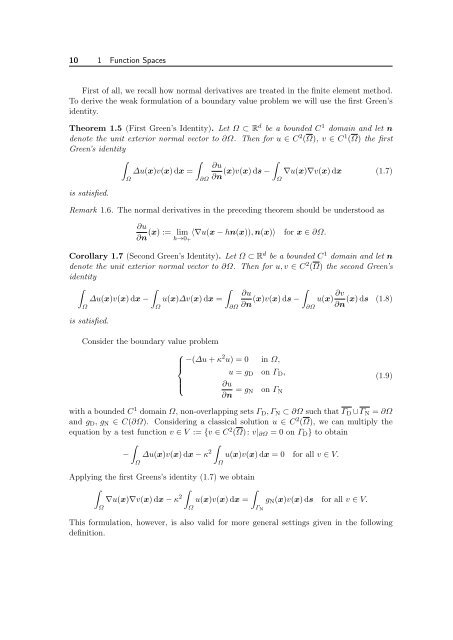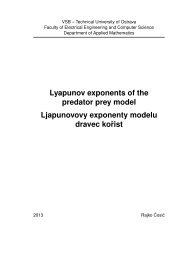The Boundary Element Method for the Helmholtz Equation ... - FEI VÅ B
The Boundary Element Method for the Helmholtz Equation ... - FEI VÅ B
The Boundary Element Method for the Helmholtz Equation ... - FEI VÅ B
Create successful ePaper yourself
Turn your PDF publications into a flip-book with our unique Google optimized e-Paper software.
10 1 Function SpacesFirst of all, we recall how normal derivatives are treated in <strong>the</strong> finite element method.To derive <strong>the</strong> weak <strong>for</strong>mulation of a boundary value problem we will use <strong>the</strong> first Green’sidentity.<strong>The</strong>orem 1.5 (First Green’s Identity). Let Ω ⊂ R d be a bounded C 1 domain and let ndenote <strong>the</strong> unit exterior normal vector to ∂Ω. <strong>The</strong>n <strong>for</strong> u ∈ C 2 (Ω), v ∈ C 1 (Ω) <strong>the</strong> firstGreen’s identityis satisfied.Ω∆u(x)v(x) dx =∂Ω∂u∂nΩ(x)v(x) ds − ∇u(x)∇v(x) dx (1.7)Remark 1.6. <strong>The</strong> normal derivatives in <strong>the</strong> preceding <strong>the</strong>orem should be understood as∂u(x) := lim ⟨∇u(x − hn(x)), n(x)⟩∂n h→0 +<strong>for</strong> x ∈ ∂Ω.Corollary 1.7 (Second Green’s Identity). Let Ω ⊂ R d be a bounded C 1 domain and let ndenote <strong>the</strong> unit exterior normal vector to ∂Ω. <strong>The</strong>n <strong>for</strong> u, v ∈ C 2 (Ω) <strong>the</strong> second Green’sidentityΩ∆u(x)v(x) dx −is satisfied.Ωu(x)∆v(x) dx =Consider <strong>the</strong> boundary value problem∂Ω∂u∂n∂Ω(x)v(x) ds − u(x) ∂v (x) ds (1.8)∂n⎧−(∆u + κ⎪⎨2 u) = 0 in Ω,u = g D on Γ D ,(1.9)⎪⎩ ∂u∂n = g N on Γ Nwith a bounded C 1 domain Ω, non-overlapping sets Γ D , Γ N ⊂ ∂Ω such that Γ D ∪ Γ N = ∂Ωand g D , g N ∈ C(∂Ω). Considering a classical solution u ∈ C 2 (Ω), we can multiply <strong>the</strong>equation by a test function v ∈ V := {v ∈ C 2 (Ω): v| ∂Ω = 0 on Γ D } to obtain− ∆u(x)v(x) dx − κ 2 u(x)v(x) dx = 0 <strong>for</strong> all v ∈ V.ΩΩApplying <strong>the</strong> first Greens’s identity (1.7) we obtain∇u(x)∇v(x) dx − κ 2 u(x)v(x) dx = g N (x)v(x) ds <strong>for</strong> all v ∈ V.ΩΩΓ NThis <strong>for</strong>mulation, however, is also valid <strong>for</strong> more general settings given in <strong>the</strong> followingdefinition.









